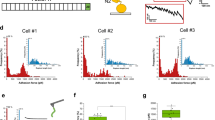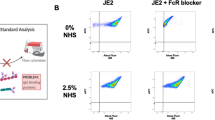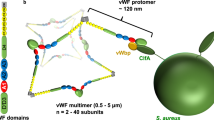Abstract
To provide insight into bacterial suppression of complement-mediated immunity, we present here structures of a bacterial complement inhibitory protein, both free and bound to its complement target. The 1.25-Å structure of the complement component C3–inhibitory domain of Staphylococcus aureus extracellular fibrinogen-binding protein (Efb-C) demonstrated a helical motif involved in complement regulation, whereas the 2.2-Å structure of Efb-C bound to the C3d domain of human C3 allowed insight into the recognition of complement proteins by invading pathogens. Our structure-function studies provided evidence for a previously unrecognized mode of complement inhibition whereby Efb-C binds to native C3 and alters the solution conformation of C3 in a way that renders it unable to participate in successful 'downstream' activation of the complement response.
This is a preview of subscription content, access via your institution
Access options
Subscribe to this journal
Receive 12 print issues and online access
$209.00 per year
only $17.42 per issue
Buy this article
- Purchase on SpringerLink
- Instant access to full article PDF
Prices may be subject to local taxes which are calculated during checkout






Similar content being viewed by others
References
Therapeutic Intervention in the Complement System (eds. Lambris, J.D. & Holers, V.M.) (Humana, Totowa, New Jersey, 2000).
Morikis, D. & Lambris, J.D. Structural Biology of the Complement System (eds. Morikis, D. & Lambris, J.D.) (Taylor & Francis, Boca Raton, Florida, 2005).
The Human Complement System in Health and Diseases (eds. Volanakis, J.E. & Frank, M.) (Marcel Dekker, New York 1998).
Patti, J.M., Allen, B.L., McGavin, M.J. & Hook, M. MSCRAMM mediated adherence of microorganisms to host tissues. Annu. Rev. Microbiol. 48, 585–617 (1994).
Chavakis, T. et al. Staphylococcus aureus extracellular adherence protein serves as anti-inflammatory factor by inhibiting the recruitment of host leukocytes. Nat. Med. 8, 687–693 (2002).
Lee, L.Y. et al. The Staphylococcus aureus Map protein is an immunomodulator that interferes with T cell-mediated responses. J. Clin. Invest. 110, 1461–1471 (2002).
Lee, L.Y.L. et al. Inhibition of complement activation by a secreted Staphylococcus aureus protein. J. Infect. Dis. 190, 571–579 (2004).
Lee, L.Y.L., Liang, X., Hook, M. & Brown, E.L. Identification and characterization of the C3 binding domain of the Staphylococcus aureus extracellular fibrinogen-binding protein (Efb). J. Biol. Chem. 279, 50710–50716 (2004).
Rooijakkers, S.H. et al. Immune evasion by a staphylococcal complement inhibitor that acts on C3 convertases. Nat. Immunol. 6, 920–927 (2005).
Hornef, M.W., Wick, M.J., Rhen, M. & Normark, S. Bacterial strategies for overcoming host innate and adaptive immune response. Nat. Immunol. 3, 1033–1040 (2002).
Sahu, A. & Lambris, J.D. Structure and biology of complement protein 3, a connecting link between innate and acquired immunity. Immunol. Rev. 180, 35–48 (2001).
Neth, O., Jack, D.L., Johnson, M., Klein, N.J. & Turner, M.W. Enhancement of complement activation and opsonophagocytosis by complexes of mannose-binding lectin with mannose-binding lectin-associated serine protease after binding to Staphylococcus aureus. J. Immunol. 169, 4430–4436 (2002).
Kawasaki, A. et al. Activation of the human complement cascade by bacterial cell walls, peptidoglycans, water-soluble peptidoglycan components, and synthetic muramylpeptides - studies on active components and structural requirements. Microbiol. Immunol. 31, 551–569 (1987).
Bredius, R.G., Driedijk, P.C., Schouten, M.F., Weening, R.S. & Out, T.A. Complement activation by polyclonal immunoglobulin G1 and G2 antibodies against Staphylococcus aureus, Haemophilus influenzae type B, and tetanus toxoid. Infect. Immun. 60, 4838–4847 (1992).
Verbrugh, H.A., Van Dijk, W.C., Peters, R., Van Der Tol, M.E. & Verhoef, J. The role of Staphylococcus aureus cell-wall peptidoglycan, teichoic acid, and protein A in the processes of complement activation and opsonization. Immunology 37, 615–621 (1979).
Wilkinson, B.J., Kim, Y., Peterson, P.K., Quie, P.G. & Michael, A.F. Activation of complement by cell surface components of Staphylococcus aureus. Infect. Immun. 20, 388–392 (1978).
Sakiniene, E., Bremell, T. & Tarkowski, A. Complement depletion aggravates Staphylococcus aureus septicaemia and septic arthritis. Clin. Exp. Immunol. 115, 95–102 (1999).
Palma, M., Nozohoor, S., Schennings, T., Heimdahl, A. & Flock, J.-I. Lack of the extracellular 19-kilodalton fibrinogen-binding protein from Staphylococcus aureus decreases virulence in experimental wound infection. Infect. Immun. 64, 5284–5289 (1996).
Nagar, B., Jones, R.G., Diefenbach, R.J., Isenman, D.E. & Rini, J.M. X-ray crystal structure of C3d: aC3 fragment and ligand for complement receptor 2. Science 280, 1277–1281 (1998).
Harboe, M., Ulvund, G., Vien, L., Fung, M. & Mollnes, T.E. The quantitative role of alternative pathway amplification in classical pathway induced terminal complement activation. Clin. Exp. Immunol. 138, 439–446 (2004).
Hack, C.E. et al. Disruption of the internal thioester bond in the third component of complement, (C3) which results in the exposure of neodeterminants also present on activation products of C3. An analysis with monoclonal antibodies. J. Immunol. 141, 1602–1609 (1988).
Nishida, N., Walz, T. & Springer, T.A. Structural transitions of complement component C3 and its activation products. Proc. Natl. Acad. Sci. USA 103, 19737–19742 (2006).
Janssen, B.J.C. et al. Structures of complement component C3 provide insights into the function and evolution of immunity. Nature 437, 505–511 (2005).
Janssen, B.J., Christodoulidou, A., McCarthy, A., Lambris, J.D. & Gros, P. Structure of C3b reveals conformational changes that underlie complement activity. Nature 444, 213–216 (2006).
Isenman, D.E. & Cooper, N.R. The structure and function of the third component of human complement 1. The nature and extent of conformational changes accompanying C3 activation. Mol. Immunol. 18, 331–339 (1981).
Isenman, D.E., Kells, D.I.C., Cooper, N.R., Muller-Eberhard, H.J. & Pangburn, M.K. Nucleophilic modification of human complement component protein C3: correlation of conformational changes with acquisition of C3b-like functional properties. Biochemistry 20, 4458–4467 (1981).
Isenman, D.E. Conformational changes accompanying proteolytic cleavage of human complement protein C3b by the regulatory enzyme factor I and its cofactor H. Spectroscopic and enzymological studies. J. Biol. Chem. 258, 4238–4244 (1983).
Nilsson, B. et al. Confomational differences between surface-bound and fluid-phase complement component-C3 fragments. Epitope mapping by cDNA expression. Biochem. J. 282, 715–721 (1992).
Winters, M.S., Spellman, D.S. & Lambris, J.D. Solvent accessibility of native and hydrolyzed human complement component 3 analyzed by hydrogen/deuterium exchange and mass spectrometry. J. Immunol. 174, 3469–3474 (2005).
Lindahl, G., Sjobring, U. & Johnsson, E. Human complement regulators: a major target for pathogenic microorganisms. Curr. Opin. Immunol. 12, 44–51 (2000).
Zipfel, P.F. et al. Factor H family proteins: on complement, microbes and human diseases. Biochem. Soc. Trans. 30, 971–978 (2002).
Hammel, M., Ramyar, K.X., Spencer, C.T. & Geisbrecht, B.V. Crystallization and X-ray diffraction analysis of the complement component-3 (C3) inhibitory domain of Efb from Staphylococcus aureus. Acta. Cryst. F. 62, 285–288 (2006).
Terwilliger, T.C. & Berendzen, J. Automated MAD and MIR structure solution. Acta Crystallogr. D Biol. Crystallogr. 55, 849–861 (1999).
Terwilliger, T.C. Maximum likelihood density modification. Acta Crystallogr. D Biol. Crystallogr. 56, 965–972 (2000).
Terwilliger, T.C. Automated main-chain model-building by template-matching and interative fragment extension. Acta Crystallogr. D Biol. Crystallogr. 59, 34–44 (2002).
Jones, T.A., Zou, J.-Y., Cowan, S.W. & Kjeldgaard, M. Improved methods for the building of protein models in electron density maps and the location of errors in the models. Acta Crystallogr. D Biol. Crystallogr. 47, 110–119 (1991).
Brunger, A.T. et al. Crystallography & NMR system: a new software suite for macromolecular structure determination. Acta Crystallogr. D Biol. Crystallogr. 54, 905–921 (1998).
Murshudov, G.N., Lebedev, A., Vagin, A.A., Wilson, K.S. & Dodson, E.J. Efficient anisotropic refinement of macromolecular structures using FFT. Acta Crystallogr. D Biol. Crystallogr. 55, 247–255 (1999).
Winn, M., Isupov, M. & Murshudov, G.N. Use of TLS parameters to model anisotropic displacments in macromolecular refinement. Acta Crystallogr. D Biol. Crystallogr. 57, 122–133 (2001).
The Collaborative Computational Crystallography Project 4. The CCP4 suite: programs for protein crystallography. Acta Cryst. D 50, 760–763 (1994).
Nicholls, A., Sharp, K.A. & Honig, B. Protein folding and association: insights from the interfacial and thermodynamic properties of hydrocarbons. Proteins 11, 281–296 (1991).
Zemla, A. LGA: a method for finding 3D similarities in protein structures. Nucleic Acids Res. 31, 3370–3374 (2003).
Kraus, D., Medof, D.E. & Mold, C. Complementary recognition of alternative pathway activators by decay-accelerating factor and factor H. Infect. Immun. 66, 399–405 (1998).
Sfyroera, G., Katragadda, M., Morikis, D., Isaacs, S.N. & Lambris, J.D. Electrostatic modeling predicts the activities of orthopoxvirus complement control proteins. J. Immunol. 174, 2143–2151 (2005).
Becherer, J.D., Alsenz, J., Esparza, I., Hack, C.E. & Lambris, J.D. A segment spanning residues 727–768 of the complement C3 sequence contains a neoantigenic site and accomodates the binding of CR1, factor H, and factor B. Biochemistry 31, 1787–1794 (1992).
Acknowledgements
We thank Z. Jin and J. Chrzas of SER-CAT beamlines 22-ID and 22-BM from the Advanced Photon Source of Argonne National Laboratory for technical assistance with diffraction data collection; A. Rux and B. Sachais (University of Pennsylvania) for support with the Biacore 2000; and D. Leahy, S. Bouyain and K. Ramyar for comments during the preparation of this manuscript. C3-9 was provided by C. Erik Hack (Central Laboratory of The Netherlands Red Cross Blood Transfusion Service). Supported by the School of Biological Sciences at the University of Missouri-Kansas City, the University of Missouri Research Board (2509 to B.V.G.) and the National Institute of Allergy and Infectious Diseases (AI30040 to J.D.L.).
Author information
Authors and Affiliations
Contributions
M.H. and B.V.G., structural biology and titration calorimetry; G.S., D.R., P.M. and J.D.L., functional assays and SPR.
Corresponding author
Ethics declarations
Competing interests
Michal Hammel, Georgia Sfyroera, Daniel Ricklin, Paola Magotti, John D Lambris & Brian V Geisbrecht B.V.G. and J.D.L. have applied for a provisional patent concerning potential therapeutic applications of the complexes described.
Supplementary information
Supplementary Fig. 1
Structural comparisons between Efb-C and a protein A module from S. aureus. (PDF 123 kb)
Supplementary Fig. 2
Spatial relationship of Efb-C to the conserved acidic groove of C3d as seen in the Efb-C–C3d crystal structure. (PDF 711 kb)
Supplementary Fig. 3
Structural integrity of the Efb-C-(RENE) mutant. (PDF 595 kb)
Supplementary Fig. 4
Efb-binding renders C3 susceptible to proteolysis in vitro. (PDF 56 kb)
Supplementary Fig. 5
Degradation of C3 in complement-inactivated plasma in the presence of Efb-C. (PDF 181 kb)
Supplementary Fig. 6
Alternative depiction of structural models for Efb-C bound to C3 and C3b. (PDF 417 kb)
Rights and permissions
About this article
Cite this article
Hammel, M., Sfyroera, G., Ricklin, D. et al. A structural basis for complement inhibition by Staphylococcus aureus. Nat Immunol 8, 430–437 (2007). https://doi.org/10.1038/ni1450
Received:
Accepted:
Published:
Issue Date:
DOI: https://doi.org/10.1038/ni1450



